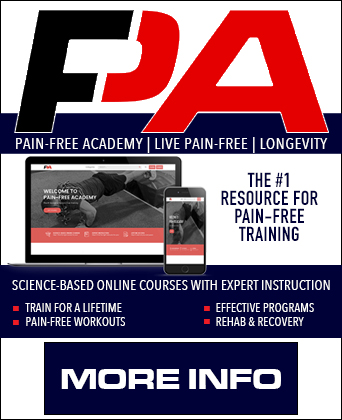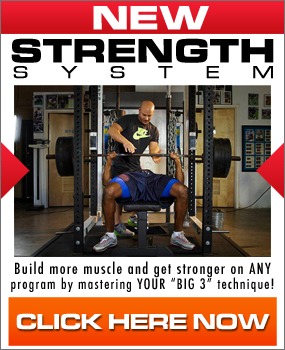Breaking Down the One Leg Squat
Breaking Down the One Leg Squat
By Ben Bruno
http://www.benbruno.blogspot.com/

About two months ago I wrote a guest blog post called 7 Single Leg Squat Variations and Why You Should be Doing Them in which I showed 7 different rear foot elevated split squat variations (aka. Bulgarian Split Squats). It received a few comments saying that the title was a little misleading because a rear foot elevated split squat is not a true one leg squat. This is a fair point and one I did not really consider when writing the article. Truth be told, I just picked that title because I thought 7 Rear Foot Elevated Split Squat Variations sounded clunky. Nevertheless, the comments got me thinking that it might be a good idea to write a little something about true one leg squats, sometimes known as pistol squats. Another comment asked for a video of a pistol. Well, I did one better. I included six videos.
During the rear foot elevated split squat (RFESS), while the majority of the work is being done by the front leg, the back leg does help out to some degree, especially in providing balance. Thus, I guess technically it is not a true one leg squat. Enter the pistol. In a pistol squat, there is only one point of contact and the working leg is supporting the entire body, making the balance demands much higher. In one sense, I would call the pistol squat a progression from the RFESS; in another sense, I would simply call it a variation. Let me explain. I call it a progression because it is much more difficult to perform than a RFESS simply due to the balance and mobility demands. However, to me at least, the term progression implies that one is better than the other. This is not the case in this situation. The RFESS and the pistol are both great exercises in their own right; they are just different.
With that said, I recommend becoming proficient at the RFESS before attempting the pistol. This will help get the hip stabilizers strong and the glutes learning how to fire properly. Once you have the hang of the RFESS, it is time to move on to a one leg squat. The best place to start is with a one leg squat to a bench. This is essentially a pistol squat with a limited depth. Stand on one leg, sit on the bench, and stand back up. If this is too difficult, sit down on the bench with two legs and stand up with one. From there, focus on sitting down with one leg, being sure to control the eccentric, and then stand up with two legs. From there, perform the full movement on one leg. I also recommend holding small dumbells (5-7.5 lbs.) in your hands to serve as a counterbalance. It may seem counterintuitive, but holding dumbbells will actually make it easier than using no weight at all.
Once you are comfortable with a one leg squat to a bench, it’s time to increase the depth. Rather than reduce the bench height, I recommend using a second small step to stand on in front of the bench. This will allow your non-working leg to drop down a little bit, taking pressure off the hip flexor. Some people complain of lower back pain that results from hip flexor tightness as a result of keeping their non-working leg elevated, so standing on a step helps mitigate that problem. Gradually increase the height of the front step until your thigh is parallel to the ground when you touch the bench (this height will different based on individual anthropometry). At this point, there are two directions you can go: you can start loading the exercise at the parallel depth, or you can progress to full “pistol” squats.
I think both options are great. The advantages of using the parallel box method are that you can load the exercise with more weight, avoid rounding the lower back, and it may be more knee friendly than dropping into a full pistol squat. Taller athletes may also find it uncomfortable to do full pistols because their legs are too long and it causes cramping in the hip flexor of the inactive leg. I personally use both methods, but for anyone with knee issues or for taller athletes, I would just stick to a parallel one leg squat to a box. Remember though, this is a not a typical box squat. You are not resting on the box; instead, it is just there to gauge depth because most people will inevitably start cutting their squats high as they fatigue. Here is how it looks in action.
On the other hand, people that can do full pistols without knee pain and without excessive rounding of the spine may find them useful because it promotes greater mobility. A good first step is to do them standing on a box so the non-working leg can drop down lower than the working leg without hitting the floor. This allows you to achieve full depth in the squat on the working leg while limiting the need to keep your non-working leg flexed, which can be uncomfortable for some people. It allows most people to remain a little more upright during the movement, meaning they will not round their lower back as much. To perform the exercise, stand on the edge of the box with the outside (non-working) leg dangling off the side. From there, sit back and reach the outside leg down as you begin to descend while at the same time raising the dumbells to eye level. Once you reach the desired depth, push through the heel of your working leg while bringing the dumbells back down to your waist. Take a moment to gather your balance before beginning the next rep. You want to be sure to avoid bouncing out of the bottom, so it is paramount that you control each and every rep.
Once you feel comfortable performing the pistol squat off a box, you may want to continue on to doing them from the floor. Again, this is completely personal preference. Doing them off the box is perfectly fine. The movement is essentially the same, but doing them from the floor requires more hip flexion of the non-working leg. With the full pistol, I find it useful to place a small wedge under my heel so I can get to full depth without my back rounding. If you don’t need the wedge, then don’t use it. Balance becomes harder the deeper you go into the squat, and the natural tendency is to have the knee collapse inward (valgus collapse). One way to help this problem is to place a band around your knees and focus on keeping the legs separated, which will force you to push your knees out. Furthermore, I have found that when using the small dumbbells to counterbalance myself, it actually helps if I raise them up SLIGHTLY towards the leg I am intending to work. So if I am squatting on my left leg, I angle my arms ever so slightly to the left. This is very subtle, and overdoing it will cause you to get all twisted up.
No matter what you do, the pistol is going to feel awkward at first. A lot of people get frustrated with the learning phase and just quit. Bad idea. If you are patient and followed the progression I outlined, it will come quicker than you might expect. Once you get the hang of it, it is a great exercise to simultaneously work single leg strength, hip mobility, and proprioception. There are several ways to incorporate into your program, depending on your goals. You can do it with just bodyweight for higher reps, or add weight and focus on strength. I do both. Here are a few examples.
Another variation is to use unstable surfaces such as a foam pad. Standing on the pad creates instability which can help to develop greater balance and proprioception. To be honest, I am not a huge fan of unstable surfaces for lower body training in general because it is not great for strength development, but I do like it in certain circumstances such as on deload weeks when I do want to use heavy weights but still want a good training effect, wince the balance demands are much higher. I wouldn’t overdo this technique, but if nothing else, it could be a fun challenge.
Between the 7 RFESS variations and now the pistol squat, that should give you enough to keep you busy for awhile. It never hurts to have more tools in the toolbox. Enjoy!
About the Author
You can find more from Ben at his blog at http://www.benbruno.blogspot.com/. Be sure to subscribe to his You Tube page at http://www.youtube.com/user/bruno082985 and follow him on Twitter at http://twitter.com/benbruno1.
By Smitty on June 23rd, 2011
FREE DIESEL NEWSLETTER
- Discover Pain Free, Joint-Friendly Training
- Get Super Effective Workouts and Programs
- Inspirational Life Lessons Each Week
- Effective Habits For Busy Entrepreneurs













This article was great. That was some really intense lower body work.
Speaking of lower body, you never picked a winner for the “Diesel Strength Challenge – 10 Goblet Squats with 50% of Your Bodyweight”. I check all the time.
Yes, I still need to pick a winner, thanks for the reminder.